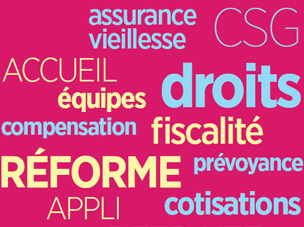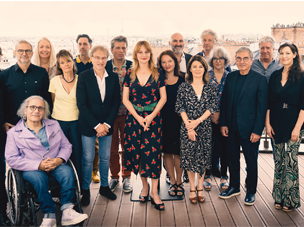Social reforms, tax, training, new services, etc. Every beginning of the year is synonymous with new things. Many authors, composers, and publishers ask questions about the legislative or regulatory developments that affect their rights and their professional lives. At the same time, 2019 marks an important year in Sacem's relations with its members. Zoom in on what has changed since 1 January
At Sacem:
Personalised welcome

The teams in charge of welcoming members of Sacem have been reorganised to better cater for the needs and expectations of authors, composers, and publishers in their diversity. Thibaud Fouet, Director of Corporate Relations, recalls the objective: "to put the member at the centre of the relationship in order to keep the promise of an accessible Sacem, serving all and adapted to each". Each call, email, or visit of a member is handled by a dedicated team, who will answer questions and direct members to professional services as and when necessary. A five-person unit has been set up to support professional (sociétaires professionnels) and full (sociétaires définitifs) members more individually, and to monitor their files in a personalised manner.
The teams in charge of welcoming members of Sacem have been reorganised to better cater for the needs and expectations of authors, composers, and publishers in their diversity. Thibaud Fouet, Director of Corporate Relations, recalls the objective: "to put the member at the centre of the relationship in order to keep the promise of an accessible Sacem, serving all and adapted to each". Each call, email, or visit of a member is handled by a dedicated team, who will answer questions and direct members to professional services as and when necessary. A five-person unit has been set up to support professional (sociétaires professionnels) and full (sociétaires définitifs) members more individually, and to monitor their files in a personalised manner.
Joining made easier
The conditions for becoming a Sacem member have been relaxed. Now it is enough to demonstrate the exploitation of one work for authors and composers, and four works for publishers. To this end, only one of the supporting documents below must be provided:
- a screenshot of an online broadcast platform showing the availability of the work
- a copy of a jacket with mention of the title of the work (trade support)
- a certificate of public performance (concert, radio pass, etc.)
- a screenshot of a user-generated content platform (YouTube type) showing at least 1,000 plays or views
In certain cases, if this threshold is not reached, the Board of Directors may rule by derogation
Your app: register your performances!
Downloadable on smartphone, Sacem makes your life easier with the brand new mobile app. Register all your performances (programmes and dates) directly via the app wherever you are. Today, it is the best guarantee of receiving authors' rights quickly and with real traceability.
1. Create your programme by finding the works that you will be performing using a search engine.
2. You associate one or more concert or show dates immediately to your programme. You can register up to one year before, and for two months after, the date of the concert. You no longer need to complete or return any paper-based dates and programmes to Sacem.
More than four thousand members have already downloaded the app since its launch in January, and have registered more than 2,500 show dates.
Co-authors, co-composers: share rights freely
New rules for sharing rights were voted at the Extraordinary General Meeting last June. The sharing "by third" rule (one third for the author, one third for the composer, and one third for the publisher) remains the foundation on which Public Performance Rights (PPR)(1) are allocated. However, within the third reserved for authors or the one reserved for composers, sharing between the various co-authors or co-composers was until now egalitarian, i.e. each received the same amount. This rule was no longer adapted to all situations and did not faithfully reflect the creative contribution of each party. It was sometimes even a disincentive, discouraging some to ask for help from other authors or composers. Now authors and composers can edit this sharing rule. How? By choosing to apply the sharing that they have already defined contractually together for the distribution of mechanical rights (DRM)(2).
In practice
Example: you have created a work amongst four (two authors, two composers) and there are two publishers to publish it. The distribution within pie charts depends on the publishing contract.
(1) Rights collected during the interpretation of a work (concert, TV, radio, etc.)
(2) Rights collected during the fixation of a work (online, CD, DVD, etc.)
At National Level:
CSG: compensation measures
Since 1st January 2018, the CSG (general social contribution) has increased for all assets in France. Although compensation for this increase was made for almost all of them, creative artists did not benefit from this. Sacem and all the professional organisations have mobilised, with their supervisory authority, through the Ministry of Economy and the Ministry of Social Affairs, to create a compensation mechanism for artists, authors, and composers. The result of this active and collective mobilisation is a reimbursement of 0.95%, expected in 2018 and 2019. A permanent compensation mechanism of 1.15%, planned by the State, will be in effect as from 1st January 2020.
Taxes: withholding tax
Since 1st January, withholding tax is in force. In concrete terms, this means that the employer deducts the tax directly from salary. This is also the case for retirement pensions and other supplemental income, such as the allowances of the RAES. But what about authors' rights? This is the income from independent work, considered by nature as non-commercial profit, even though it can be declared as a salary. This is the reason why tax is not retained directly on the authors' rights paid by Sacem. A fixed monthly advance payment (or quarterly on request) is collected by the tax authorities from the bank account of the songwriter. This amount has been calculated by the tax authorities on the basis of the last declared income, and is detailed on the tax notice (or in the personal space on impots.gouv.fr). It can be adjusted up or down on demand according to forecasts made by the songwriter, but these forecasts must be properly evaluated, under penalty of increase. It should be noted that the tax authorities will readjust these advance payments in September 2019 based on the 2018 income, to be declared next spring.
Compulsory retirement provision contribution
Since 1st January, the retirement provision contribution (6.9%) has been deducted from authors' rights, in the same way as other social security contributions. This is an obligation for all collective management organisations, imposed by the Social Security financing law. For all authors and composers who were already affiliated with Agessa, this deduction is a simplification. It replaces the contribution of the same amount that the affiliated creative artists paid at the request of Agessa. For all the others, this is about security: all creative artists must pay that contribution, which opens up rights to the basic retirement pension of Social Security. Up until now, the retirement provision contribution was the only one not deducted from authors' rights. This peculiarity has created difficulties for many creative authors, who often believed they had contributed for their retirement pension, only to discover that they had not constituted rights to a retirement pension at the time they asked for their liquidation.
And the pension reform?
A pension reform is currently under preparation. Launched by the current Government, this reform aims to create a universal system: one Euro contributed will give the same rights to all. It should be presented in the second half of 2019 for gradual application as from 2025. Sacem and the professional organisations are nevertheless already taking action, and are actively lobbying with the High Commissioner for Pension Reform, Jean-Paul Delevoye, in order to take into account the specific situation of creative artists (whose contributions, in particular, do not include an "employer's share"), so that their pension coverage is not degraded, either by a sharp increase in contributions, or by a loss of rights.
New training rights
The law for the freedom to choose one's professional future, voted on 5th September, reinforces the training rights of creative artists, and opens a new financing mechanism for them: from 2019, any creative artist who contributes under vocational training has access to the Personal Training Account (CPF). This year, this personal account will be credited with 360 Euros (and managed, as a transitional measure, by Afdas), after which it will be credited with 500 Euros per year, up to a limit of 5,000 Euros maximum, and managed by the Caisse des Dépôts et Consignations (Deposits and Consignments Fund). The amounts thus credited can be used to finance certain types of training, mainly certifying training or degree courses. They can be used as from 2019. The technical opening of the personal training accounts (i.e. the possibility to consult on line one's situation, credits, etc.) will only be effective in 2020.
Published April 15 2019


